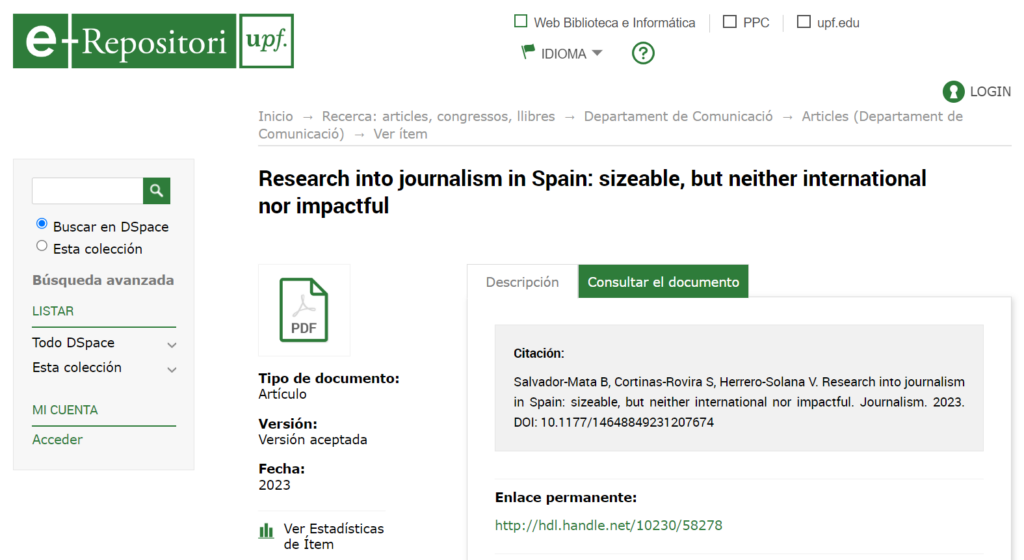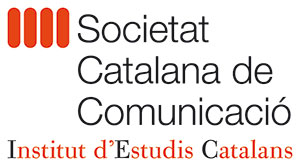
Abstract
Until 2021, studies of scientific disciplines took as their object of study papers published in journals from certain subject categories. This paper is one of the firsts to analyse research into journalism in Spain using the Clarivate InCites analytics platform algorithm that groups papers together according to their citation relations (Citation Topics, CT) rather than by the category of the journals themselves.
A unique universe was obtained made up of 63,694 items on the Web of Science, this being the global output of the CT ‘Journalism’ (1980–2022, both included). Spain is the world’s third producer by number of items (4635), but only seventh in citations (and has the lowest proportion of citations per paper, (7.151). Most of the papers (34.01%) are published in Q3 (unlike the rest of the countries analysed, which publish more in Q1 and Q2) and in national journals (61%, even more than the US or the UK, 52% and 47%, respectively), edited by small, non-commercial publishers. Only 40.6% of the items are in the WoS Flagship citation index databases (SCIE, SSCI and AHCI).
Most Spanish journals publish national research in proportions around 80%. Spanish research tends to collaborate internationally to a lesser extent (16.5%) than the other European countries analysed, and no significant change has been apparent over the last years. Spanish research into journalism is very productive but has little international presence, obtains few citations per paper, and shows no clear signs of progress towards greater international collaboration.
Keywords
academic performance, academic success, citations, algorithm, citation topic, collaboration, internationalisation, inCites, impact, journalism
Introduction
The academic discipline of Communication has experienced an institutional and scientific boom in recent years, making it one of the most productive branches of social sciences, despite its tender years (Berg et al., 2009; Barnet et al., 2011; Koivisto and Thomas, 2010). It has been defined as a vaguely related group of sub-disciplines or a catch-all for different academic traditions that coexist with emerging fields of research.
The fact that it is considered a discipline of late origin (Barnet et al., 2011) has contribute to this sensation. However, an institutional, pedagogical and academic structure has been consolidated over the years that has increased its presence, although authors of reference point out that the discipline lacks a clear ontological centre, and its lines of research are fragmented and remote (Waisbord, 2019). This analysis is not far from Peter’s (1993), who argued that communication carries identity problems.
Herbst (2008) also echoes Waisbord’s perspective by regarding communication as a post-discipline, insofar as it is versatile, entangled, and constantly changing. Conversely, Craig (2018) argues that Communication ought to be regarded as a practical discipline, emphasizing its practical applications over purely theoretical or empirical aspects. These theories have been accompanied by numerous research efforts aiming to define this discipline empirically through the retrieval and analysis of extensive datasets (Karaboga et al., 2020).
Most of this research has concentrated on journals indexed within the subject category of Communication in the Journal Citation Reports (JCR-SSCI). The work of Song et al. (2020) studied the discipline based on a thematic analysis of papers published in the 20 most renowned journals in the field (2010–2019), finding that the discipline is not as fragmented as it might seem. On the contrary, the behaviour of the obtained matrix resembled more relational and less disruptive models. However, their sample was focused on a few journals, which may generate bias due to the quality and relationships between them. Barnett et al. (2011) analysed the citation patterns among journals, identifying the centrality of the Journal of Communication and Communication Research.
From a thematic point of view, Montero-D´ıaz et al. (2018), analysing articles published in journals indexed in WoS under Communication, suggested a growing disconnection among the main thematic areas, somewhat contrasting with the findings of Song et al. (2020). Steensen and Ahva’s (2015) examined the abstracsts of the articles published in Journalism and Journalism Studies (2000–2013), also noting the thematic expansion of the field.Walter et al. (2018) analysed 1574 articles published by the Journal of Communication, emphasizing the presence of broader perspectives while also underscoring the central role of the United States. In fact, up to a third of the works gathered in Scopus in the field of Communication originate from the United States (Trabadela-Robles et al., 2020).
(…)
Useful links
- Article record (metadata and download links) in Journalism journal web platform
- Journalism journal main site
- PDF author’s version Repositori UPF
